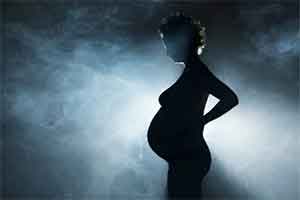Air pollution exposure during pregnancy linked with asthma risk
 Babies born to mothers exposed to air pollution from traffic sources during pregnancy have an increased risk of developing asthma before the age of 5 years, according to new findings.
Babies born to mothers exposed to air pollution from traffic sources during pregnancy have an increased risk of developing asthma before the age of 5 years, according to new findings.
Published in the European Respiratory Journal, the new research is one of the largest studies to look at the role of variation in air pollution in urban areas and the development of asthma.
Over 65,000 Canadian children were included in the study and followed up from birth until the age of 10 years. The researchers monitored physician-diagnosed asthma cases among this group and also assessed exposure of the mother’s to air pollutants during pregnancy. Each mother’s postcode was used and exposure level was determined using three measures:
Land use regression models, which combine traffic-related air pollutant monitoring data and geographical information around the home address
Measurements of air pollutants from monitoring stations close to each mother
Assessing whether each mother in the study lived close to a major road.
The measurements focused mainly on traffic-related pollutants, including black carbon, fine particulate matter, nitrogen oxide and nitric oxide.
The findings revealed that exposure to air pollution from traffic sources during pregnancy increases the risk of developing asthma during the first 5 years of life, even in urban areas with relatively low levels of pollution. Children whose mothers lived close to highways during pregnancy had a 25% increased relative risk of developing asthma before the age of five.
The risk increased with an increase in levels of nitrogen dioxide and carbon monoxide: two markers of traffic-related air pollution. In addition, children born with a low birth weight were more susceptible to the respiratory effects of air pollution. The results were found after other factors, such as low birth weight at term, gestational period, breastfeeding and socio-economic factors had been controlled for.
Lead author, Dr Hind Sbihi, from the University of British Columbia, Vancouver, said: “Our study results highlight the importance of exposure to pollution while babies are still in the womb. Air pollution from traffic sources increased the risk of developing asthma during early years before children reach school age, even in an urban area with relatively low levels of air pollution. There are some measures individuals can take to reduce this risk. First we would suggest installing high-efficiency particulate air (HEPA) filters in the home and avoiding busy routes when taking a stroll. You can also check air quality levels online and postpone high-intensity physical activity until conditions improve.”
Commenting on the findings, Chair of the European Lung Foundation, Dan Smyth, said: “Air pollution affects 100% of the population and this study highlights the harmful effects of air pollution right from the moment we are created. A large proportion of Europe’s population live in areas with unhealthy outdoor air and it is essential that we increase awareness of the dangers of polluted air. Our Healthy Lungs for Life campaign aims to do this by focusing on measures to help prevent damaging lung conditions. Urgent action is needed to tackle the rising levels of air pollution. We believe that an ambitious EU National Emission Ceilings (NEC) Directive, which revises limit values for ambient air and which is currently negotiated between the EU institutions, is an essential tool to achieve this aim.”
Source: European Respiratory Society (ERS)
Full bibliographic information:
Perinatal air pollution exposure and development of asthma from birth to age 10 years; Hind Sbihi, Lillian Tamburic, Mieke Koehoorn, Michael Brauer; European Respiratory Journal;

